Numidia
Numidia was the ancient kingdom of the Numidians in northwest Africa, initially comprising the territory that now makes up Algeria, but later expanding across what is today known as Tunisia and Libya. The polity was originally divided between the Massylii in the east and the Masaesyli in the west. During the Second Punic War (218–201 BC), Masinissa, king of the Massylii, defeated Syphax of the Masaesyli to unify Numidia into the first Berber state in present-day Algeria.[7] The kingdom began as a sovereign state and later alternated between being a Roman province and a Roman client state.
Kingdom of Numidia | |||||||||||||||
|---|---|---|---|---|---|---|---|---|---|---|---|---|---|---|---|
| 202 BC–25 BC | |||||||||||||||
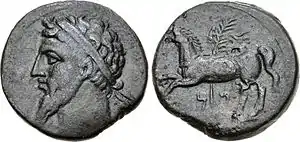 Numidian coins under Massinissa | |||||||||||||||
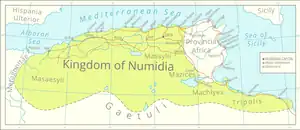 Map of Numidia after the Punic wars. | |||||||||||||||
| Capital | Cirta (today Constantine, Algeria) | ||||||||||||||
| Common languages | Numidian[lower-alpha 1] Punic[lower-alpha 2] Latin[lower-alpha 3] Greek[lower-alpha 4] | ||||||||||||||
| Government | Monarchy | ||||||||||||||
| King | |||||||||||||||
• 202–148 BC | Masinissa | ||||||||||||||
• 60–46 BC | Juba I of Numidia | ||||||||||||||
• 30–25 BC | Juba II of Numidia | ||||||||||||||
| Historical era | Antiquity | ||||||||||||||
• Established | 202 BC | ||||||||||||||
• Annexed by the Roman Empire | 25 BC | ||||||||||||||
| |||||||||||||||
| Today part of | |||||||||||||||
| History of Algeria |
|---|
Numidia, at its largest extent, was bordered by Mauretania to the west, at the Moulouya River,[8] Africa Proconsularis to the east, the Mediterranean Sea to the north, and the Sahara to the south.
History
Independence
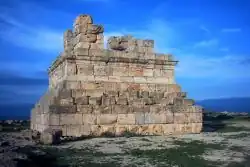
The Greek historians referred to these peoples as "Νομάδες" (i.e. Nomads), which by Latin interpretation became "Numidae" (but cf. also the correct use of Nomades).[9] Historian Gabriel Camps, however, disputes this claim, favoring instead an African origin for the term.[10]
The name appears first in Polybius (second century BC) to indicate the peoples and territory west of Carthage including the entire north of Algeria as far as the river Mulucha (Muluya), about 160 kilometres (100 mi) west of Oran.[11]
The Numidians were composed of two great tribal groups: the Massylii in eastern Numidia, and the Masaesyli in the west. During the first part of the Second Punic War, the eastern Massylii, under their king Gala, were allied with Carthage, while the western Masaesyli, under king Syphax, were allied with Rome. The Kingdom of Masaesyli under Syphax extended from the Moulouya river to Oued Rhumel.[12]

However, in 206 BC, the new king of the eastern Massylii, Masinissa, allied himself with Rome, and Syphax of the Masaesyli switched his allegiance to the Carthaginian side. At the end of the war, Numidia was under the rule of Masinissa of the Massylii.[11] At the time of his death in 148 BC, Masinissa's territory extended from the Moulouya to the boundary of the Carthaginian territory, and also southeast as far as Cyrenaica to the gulf of Sirte, so that Numidia entirely surrounded Carthage (Appian, Punica, 106) except towards the sea.[14] Furthermore, after the capture of Syphax the king in modern day Morocco with his capital based in Tingis, Bokkar, had become a vassal of Massinissa
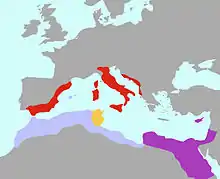
.[16][17][18] Massinissa had also penetrated as far south beyond the Atlas to the Gaetuli and Fezzan was part of his domain.[19][20]
After the death of the long-lived Masinissa around 148 BC, he was succeeded by his son Micipsa. When Micipsa died in 118 BC, he was succeeded jointly by his two sons Hiempsal I and Adherbal and Masinissa's illegitimate grandson, Jugurtha, who was very popular among the Numidians. Hiempsal and Jugurtha quarrelled immediately after the death of Micipsa. Jugurtha had Hiempsal killed, which led to open war with Adherbal.[21]
Agriculture
The Numidian kingdom was very famous for its agricultural yield, besides lettuce, beans, and other grains already consumed by Berbers since the dawn of time, Numidia was very productive when it came to its famous quality wheat, very similar to the wheat farmed along the banks of the egyptian nile. According to the Roman historian Pliny the elder:
Among the wheat imports of Rome, is light wheat imported from Gallia which does not surpass the weight of a bushel (Boisseau) 20 livres. The weight of the wheat of Sardinia supasses that of Gallia by half a livre, the wheat of Biossia surpasses that of Gallia by an entire livre, wheras the wheat of Africa surpasses the weight of wheat of Gallia by a whole livre and three fourths.
In 179 BC the king of Numidia Masinissa received a golden crown from the inhabitants of Delos as he had offered them a shipload of grain. A statue of Masinissa was set up in Delos in honour of him as well as an inscription dedicated to him in Delos by a native from Rhodes. His sons too had statues of them erected on the island of Delos and the King of Bithynia, Nicomedes, had also dedicated a statue to Masinissa.[22] By 143 AD, the export of olive oil from Numidia rivaled its grain export throughout the Roman Empire.
In 200 BC the Roman Army stationed in Macedonia received from Numidia 17,508 hectoliters of wheat, in 198 BC the Roman Army in Greece was sent once again the same amount of wheat, in 191 BC Rome received 26,262 Hectoliters of wheat and 21,885 hectoliters of Barley, and to Greece the same year 43,770 Hectoliters of wheat and 26,262 hectoliters of wheat and in 171 BC the Roman army in Macedonia received 87,540 hectoliters of wheat.
In total Rome received:[23]
- in 200 BC: 14,000 tonnes of wheat and 10,500 tonnes of barley.
- in 198 BC: 14,000 tonnes of wheat.
- in 191 BC: 56,000 tonnes of wheat and 28,900 tonnes of barley.
- in 170 BC: 70,000 tonnes of wheat.
These numbers only represent a fraction from the reserves of the kingdom of Massinissa. His contributions to the Romans in 170 BC appears to be only a fraction of the kingdom's total production because he was upset by Rome's decision to pay for the provided wheat in that year. Massinissa hadn't laid his hands yet on the fertile lands of the Emporia (North West Ancient Libya) nor the great plains full of fertile soil yet, since generally barley was his kingdom's main produce, he grew his barley generally in light mountainous and hilly soil which is suitable for its growth.
War with Rome
By 112 BC, Jugurtha resumed his war with Adherbal. He incurred the wrath of Rome in the process by killing some Roman businessmen who were aiding Adherbal. After a brief war with Rome, Jugurtha surrendered and received a highly favourable peace treaty, which raised suspicions of bribery once more. The local Roman commander was summoned to Rome to face corruption charges brought by his political rival Gaius Memmius. Jugurtha was also forced to come to Rome to testify against the Roman commander, where Jugurtha was completely discredited once his violent and ruthless past became widely known, and after he had been suspected of murdering a Numidian rival.
War broke out between Numidia and the Roman Republic and several legions were dispatched to North Africa under the command of the Consul Quintus Caecilius Metellus Numidicus. The war dragged out into a long and seemingly endless campaign as the Romans tried to defeat Jugurtha decisively. Frustrated at the apparent lack of action, Metellus' lieutenant Gaius Marius returned to Rome to seek election as Consul. Marius was elected, and then returned to Numidia to take control of the war. He sent his Quaestor Sulla to neighbouring Mauretania in order to eliminate their support for Jugurtha. With the help of Bocchus I of Mauretania, Sulla captured Jugurtha and brought the war to a conclusive end. Jugurtha was brought to Rome in chains and was placed in the Tullianum.[24]
Jugurtha was executed by the Romans in 104 BC, after being paraded through the streets in Gaius Marius' Triumph.[25]
Divided kingdom
After the death of Jugurtha, the far west of Numidia was added to the lands of Bocchus I, king of Mauretania.[11] A rump kingdom continued to be governed by native princes.[11] It appears that on the death of King Gauda in 88 BC, the kingdom was divided into a larger eastern kingdom and a smaller western kingdom (roughly the Petite Kabylie). The kings of the east minted coins, while no known coins of the western kings survive. The western kings may have been vassals of the eastern.[26][27]
The civil war between Caesar and Pompey brought an end to independent Numidia in 46 BC.[11] The western kingdom between the Sava (Oued Soummam) and Ampsaga (Oued-el-Kebir) rivers passed to Bocchus II, while the eastern kingdom became a Roman province. The remainder of the western kingdom plus the city of Cirta, which may have belonged to either kingdom, became briefly an autonomous principality under Publius Sittius. Between 44 and 40 BC, the old western kingdom was once again under a Numidian king, Arabio, who killed Sittius and took his place. He involved himself in Rome's civil wars and was himself killed.[27]
Roman provinces

Eastern Numidia was annexed in 46 BC to create a new Roman province, Africa Nova. Western Numidia was also annexed as part of the province Africa Nova after the death of its last king, Arabio, in 40 BC, and subsequently the province (except of Western Numidia) was united with province Africa Vetus by Emperor Augustus in 25 BC, to create the new province Africa Proconsularis. During the brief period (30–25 BC) Juba II (son of Juba I) ruled as a client king of Numidia on the territory of former province Africa Nova.
In AD 40, the western portion of Africa Proconsularis, including its legionary garrison, was placed under an imperial legatus, and in effect became a separate province of Numidia, though the legatus of Numidia remained nominally subordinate to the proconsul of Africa until AD 203.[28] In 193 AD, under Septimius Severus, Numidia was separated from Africa Proconsularis, and governed by an imperial procurator.[11]
In the reorganization of the empire by Diocletian, Numidia was divided in two provinces: the north became Numidia Cirtensis, with capital at Cirta, while the south, which included the Aurès Mountains and was threatened by raids, became Numidia Militiana, "Military Numidia", with capital at the legionary base of Lambaesis.
Subsequently Emperor Constantine the Great reunited the two provinces into a single one, administered from Cirta, which was now renamed Constantina (modern Constantine) in his honour. Its governor was raised to the rank of consularis in 320, and the province remained one of the six provinces of the Diocese of Africa until the invasion of the Vandals in 428, which began its slow decay,[11] accompanied by desertification. It was restored to Roman rule after the Vandalic War, when it became part of the new Praetorian prefecture of Africa.
Architecture
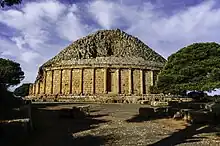
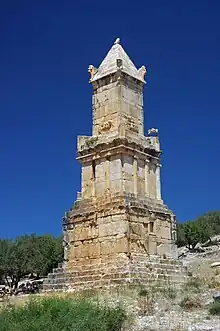
The term “Royal Numidian Architecture” was coined for the monuments that were constructed by the Numidian kings.[29] These monuments consist of tombs, tumuli and sanctuaries. Some examples of these structures are the mausoleum of Thugga, the tomb of Beni Rhenane, a tomb at Henchur Burgu in Djerba as well as two tumulus tombs known as the Madghacen and the Royal Mausoleum of Mauretania.[29] There are also altars that were built at Simitthus and Kbor Klib. All of these monuments were built within the area ruled by Massinissa and his descendants.[29]
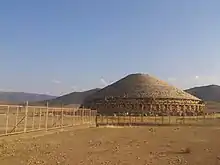
Navy and trade
Numidia took over most of the famous Carthaginian ports which were one of the most important in the mediterranean, the famous Roman orator and historian Cicero tells us that the Numidian king had a war navy to protect his trade, in one story, the fleet of Massinissa sailed to Malta and confiscated large ivory elephant pillars from the temple of Juno and returned to Numidia and gave it as a prize to Massinissa. When the king knew about the origin of the gift, he prepared a nimble fleet of five ships and sent it back to where it came from. This funny story tells us that not only Massinissa had enough ships to perform tasks at will but also these fleets were functioning outside of African shorelines towards the central mediterranean.
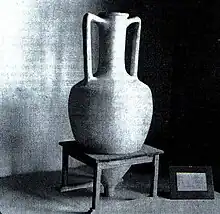
Unlike the Carthaginians who closed trade in face of the Greeks to large parts of North africa, Massinissa opened trade with the Greek, Egyptian, Syrian as well as Italic merchants, Massinissa used to provide to the population of Rhodes Toja wood and Ivory,[30] in Cirta multiple Rhodian amphorae from the 2nd century B.C were found in burial sites and one of them carries the inscription (Sodamos). [31]
Major cities
Numidia became highly romanized and was studded with numerous towns.[11] The chief towns of Roman Numidia were: in the north, Cirta or modern Constantine, the capital, with its port Russicada (Modern Skikda); and Hippo Regius (near Bône), well known as the see of St. Augustine. To the south in the interior military roads led to Theveste (Tebessa) and Lambaesis (Lambessa) with extensive Roman remains, connected by military roads with Cirta and Hippo, respectively.[11][32]
Lambaesis was the seat of the Legio III Augusta, and the most important strategic centre.[11] It commanded the passes of the Aurès Mountains (Mons Aurasius), a mountain block that separated Numidia from the Gaetuli Berber tribes of the desert, and which was gradually occupied in its whole extent by the Romans under the Empire. Including these towns, there were altogether twenty that are known to have received at one time or another the title and status of Roman colonies; and in the 5th century, the Notitia Dignitatum enumerates no fewer than 123 sees whose bishops assembled at Carthage in 479.[11]
Episcopal sees
See also
Explanatory notes
- Used especially in funerary and votive steles, with a few surviving "official" royal inscriptions.[1][2][3]
- Punic and Neo-Punic was especially dominant during the early era of the Numidian kingdom. Several official Punic inscriptions survive, and Numidian coins were minted in Punic at first, likely because it was the most influential language when it came to trade in the area. Some historians even consider it the official language of Numidia during its early/mid eras.[4]
- During the later eras of Numidia, Latin started replacing Punic as the dominant secondary language inside Numidia. Coins were minted in Latin, and inscriptions in Latin began appearing,[5] however, many of those Latin inscriptions may have been from the Roman era itself
- Greek first appeared in the region through trade routes opened up by Massinissa, and gained traction and influence by the end of the kingdom when the Numidian dynasty intermarried and mixed with the Ptolemaic dynasty.[6]
References
- Boutammina, Nas E. (2022-01-06). Le numide, langue populaire de la Berbérie (in French). Books on Demand. ISBN 978-2-322-41710-0.
- Chaker, S. (2008-01-01). "Libyque : écriture et langue". Encyclopédie berbère (in French) (28–29): 4395–4409. doi:10.4000/encyclopedieberbere.344. ISSN 1015-7344. S2CID 161729616.
- Camps, G.; Claudot-Hawad, H.; Chaker, S.; Abrous, D. (1996-08-01). "Écriture". Encyclopédie berbère (in French) (17): 2564–2585. doi:10.4000/encyclopedieberbere.2125. ISSN 1015-7344.
- Quinn, Josephine Crawley; Vella, Nicholas C. (2014-12-04). The Punic Mediterranean. Cambridge University Press. ISBN 978-1-107-05527-8.
- Hirst, Anthony; Silk, Michael (2017-05-15). Alexandria, Real and Imagined. Routledge. ISBN 978-1-351-95959-9.
- Roller, Duane W. (2004-02-24). The World of Juba II and Kleopatra Selene: Royal Scholarship on Rome's African Frontier. Routledge. ISBN 978-1-134-40296-0.
- Thomas M. Leonard (2013). Encyclopedia of the Developing World. Routledge. p. 169. ISBN 978-1-135-20508-9.
- Dictionary of Greek and Roman Geography. Retrieved 16 February 2020.
- Numida and Nomas
- Camps, Gabriel (1979). "Les Numides et la civilisation punique". Antiquités africaines (in French). 14 (1): 43–53. doi:10.3406/antaf.1979.1016.
- Chisholm, Hugh, ed. (1911). . Encyclopædia Britannica. Vol. 19 (11th ed.). Cambridge University Press. pp. 868–869.
- History of Humanity: From the seventh century B.C. to the seventh century A.D. Sigfried J. de Laet, Joachim Herrmann, UNESCO,
- Idjouadiene, Lynda; Mostefaoui, Toufik A.; Djermoune, Hocine; Ziat, Farid; Bonizzoni, Letizia (2021). "XRF analysis of ancient Numidian coins: A comparison between different kingdoms". The European Physical Journal Plus. 136 (5): 512. Bibcode:2021EPJP..136..512I. doi:10.1140/epjp/s13360-021-01458-0. S2CID 236592882.
- Historical Dictionary of Morocco Aomar Boum, Thomas K. Park Rowman & Littlefield
- Historical Dictionary of Morocco Aomar Boum, Thomas K. Park Rowman & Littlefield
- Villes et tribus du Maroc: documents et renseignements, Volume 7 Morocco. Direction des affaires indigènes: “Les rois indigènes . Bokkar . Au début du troisième siècle avant JésusChrist , le Maroc obéissait à Bokkar , qui résidait à Tanger , capitale du royaume , et qui était un lieutenant du roi de Numidie Syphax. En 202 avant Jésus - Christ , après la capture de Syphax , il devint le vassal de Massinissa” H. Champion
- Histoire du Maroc Coissac de Chavrebière Payot: “ La guerre tourna à l'avantage de Massinissa , allié des Romains . Syphax fut fait prisonnier ( 202 ) et Bokkar devint le vassal du vainqueur . « Massinissa , dit St. Gsell , rêvà d'être pour la civilisation punique ce que le Macédonien...”
- Le Maroc Prosper Ricard Hachette: “En 202 avant J.-C. , elle était la résidence , disent les Anciens , de Bokkar , roi du Maroc , lieutenant de Syphax le numide , vassal de Massinissa . En 105 avant J.-C. , Bokkus [ er , allié de Sylla , livre aux Romains son gendre”
- Histoire des Romains depuis les temps les plus reculés jusqu'à la fin du règne des Antonins: Depuis les Gracques jusqu'à la fin du règne de Claude. Victor Duruy. Hachette et cie
- Storia della Libia dai tempi piu' [i.e. più] remoti ad oggi: compendio. Muḥammad Masʻūd Fushaykah. Stabilimento poligrafico editoriale Maggi.
- Sallust (c. 40 BCE), Jugurthine War XI–XIII.
- Edward Lipiński (2004). Itineraria Phoenicia. Peeters Publishers. pp. 168–169. ISBN 978-90-429-1344-8.
- Livius, Titus (1882). Oeuvres de Tite-Live: Histoire romaine avec la traduction en français. Livres XXVII à XLV (in French). Firmin-Didot.
- Telford, Lynda (2014). Sulla: A Dictator Reconsidered. Pen and Sword. ISBN 9781473834507.
- Connolly, Peter; Gillingham, John; Lazenby, George (2016). The Hutchinson Dictionary of Ancient and Medieval Warfare. Routledge. p. 171. ISBN 9781135936747.
- Duane W. Roller (2003), The World of Juba II and Kleopatra Selene: Royal Scholarship on Rome's African Frontier, New York: Routledge, p. 25.
- Gabriel Camps (1989) [published online 2012], "Arabion", Encyclopédie berbère, 6: Antilopes–Arzuges, Aix-en-Provence: Edisud, pp. 831–34, doi:10.4000/encyclopedieberbere.2569, retrieved 13 February 2017.
- Fage, J.D.; Oliver, Roland Anthony (1975). The Cambridge History of Africa. Cambridge University Press. p. 199. ISBN 978-0-521-21592-3.
- Quinn, J. (2013). Monumental power: ‘Numidian Royal Architecture’ in context. In J. Prag & J. Quinn (Eds.), The Hellenistic West: Rethinking the Ancient Mediterranean (pp. 179-215). Cambridge: Cambridge University Press. doi:10.1017/CBO9781139505987.008
- Gsell, Stéphane (1929). Histoire d'Algérie: S[tephane] Gsell-G. Marçais-G. Yver. Ouvrage illustré de grav. hors texte (in French). Boivin.
- Antiquités africaines (in French). Editions du Centre national de la recherche scientifique. 2005. ISBN 978-2-271-06342-7.
- Detailed map of Roman Numidia
Further reading
- Daho, Keltoum Kitouni; Filah, Mohamed El Mostéfa (2003). L'Algérie au temps des royaumes numides ["Algeria at the time of the Numidian kingdoms"] (in French). Somogy Editions d'Art. ISBN 2850566527.
- Horn, Heinz Günter; Rüger, Christoph B. (1979). Die Numider. Reiter und Könige nördlich der Sahara ["The Numidians. Horsemen and kings north of the Sahara"] (in German). Rheinland. ISBN 3792704986.
- Kuttner, Ann (2013). "Representing Hellenistic Numidia, in Africa and at Rome". In Jonathan R. W. Prag, Josephine Crawley Quinn (ed.). The Hellenistic West. Rethinking the Ancient Mediterranean. Cambridge University. pp. 216–272. ISBN 978-1107032422.
- Quinn, Josephine Crawley (2013). "Monumental power: 'Numidian Royal Architecture' in context". In Jonathan R. W. Prag, Josephine Crawley Quinn (ed.). The Hellenistic West. Rethinking the Ancient Mediterranean (PDF). Cambridge University. pp. 179–215. ISBN 978-1107032422.